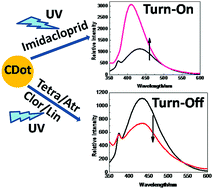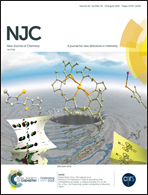Fluorescence turn-on and turn-off sensing of pesticides by carbon dot-based sensor†
Abstract
This paper describes a simple fluorescence-based method using carbon dots (C-Dots) with a green chemistry synthesis method for the detection of commonly used pesticides, such as atrazine, chlorpyrifos, imidacloprid, lindane, and tetradifon in aqueous solution. The C-Dots are synthesized from gelatin using a hydrothermal route and have amine, carboxyl, and hydroxyl groups on the surface. Because of these functionalities, the C-Dots are directly coordinated to the highly reactive –NO2 and –NH groups of imidacloprid with a high binding affinity (3.24 × 106) and selectivity, which switches the C-Dots to the more isolated state than its initial non-isolated state resulting in an enhancement of the C-Dots’ fluorescence (turn-on). In contrast, to the other four pesticides, the fluorescence of the C-Dots gets quenched (turn-off). The pesticide–C-Dot interactions are mainly a static type via a ground state non-fluorescent complex formation with an insignificant contribution from the diffusion controlled electron transfer reaction. The as-fabricated C-Dots display different binding characteristics with the different pesticides which are helpful in distinguishing the target pesticides with very low detection limits of 0.013 μM for imidacloprid and 0.04 μM for tetradifon which are comparable to the previously reported values. The results of time-resolved fluorescence lifetime and anisotropy experiments support the results. In addition, the electrochemical detection approach confirmed the findings. The recovery efficiency of 92–97%, in real river water suggested that the fabricated nanoprobe would be a good, useable sensor in practical applications. Thus, the current investigation is helpful for designing a new, easy, eco-friendly, and efficient sensing method for pesticide monitoring.



 Please wait while we load your content...
Please wait while we load your content...